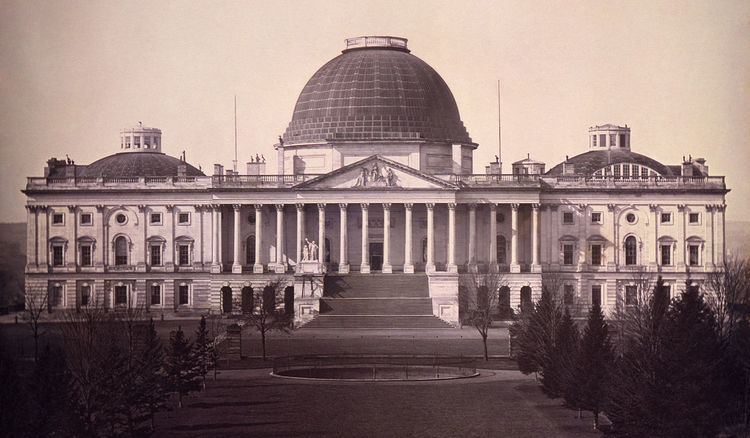The Twenty-seventh United States Congress was a meeting of the legislative branch of the United States federal government, consisting of the United States Senate and the United States House of Representatives. It met in Washington, D.C. from March 4, 1841 to March 4, 1843, during the one-month administration of U.S. President William Henry Harrison and the first two years of the administration of his successor, John Tyler. The apportionment of seats in the House of Representatives was based on the Fifth Census of the United States in 1830. Both chambers had a Whig majority.
March 4, 1841: William Henry Harrison was inaugurated as President of the United StatesApril 4, 1841: Harrison died and John Tyler became PresidentAugust 16, 1841: President Tyler's veto of a bill to re-establish the Second Bank of the United States led Whig Party members to riot outside the White House in the most violent demonstration on White House grounds in U.S. history.May 19, 1842: Dorr RebellionApril 19, 1841: Bankruptcy Act of 1841, ch. 9, 5 Stat. 440September 4, 1841: Preemption Act of 1841, ch. 16, 5 Stat. 453August 4, 1842: Armed Occupation Act, 5 Stat. 502August 30, 1842: Tariff of 1842 ("Black Tariff"), ch. 270, 5 Stat. 548August 9, 1842: Webster-Ashburton Treaty signed, establishing the United States–Canada border east of the Rocky Mountains.President: John Tyler (W), until April 4, 1841, thereafter vacantPresidents pro tempore: William R. King (D), elected March 4, 1841Samuel L. Southard) (W), elected March 11, 1841Willie P. Mangum (W), elected May 31, 1842Speaker: John D. White (W)This list is arranged by chamber, then by state. Senators are listed in order of seniority, and Representatives are listed by district.
Skip to House of Representatives, belowSenators were elected by the state legislatures every two years, with one-third beginning new six-year terms with each Congress. Preceding the names in the list below are Senate class numbers, which indicate the cycle of their election. In this Congress, Class 1 meant their term began in the last Congress, requiring reelection in 1844; Class 2 meant their term began with this Congress, requiring reelection in 1846; and Class 3 meant their term ended with this Congress, requiring reelection in 1842.
The count below reflects changes from the beginning of the first session of this Congress.
replacements: 9Democrats: no net changeWhigs: no net changedeaths: 2resignations: 8interim appointments: 0vacancy: 1Total seats with changes: 10replacements: 17Democrats: 3 seat net gainWhigs: 3 seat net lossdeaths: 8resignations: 12contested election: 1Total seats with changes: 20Lists of committees and their party leaders.
AgricultureAudit and Control the Contingent Expenses of the SenateClaimsCommerceDistributing Public Revenue Among the States (Select)District of ColumbiaFinanceFiscal Corporation of the United States (Select)Foreign RelationsIndian AffairsJudiciaryManufacturesMilitary AffairsMilitiaNaval AffairsPatents and the Patent OfficePensionsPost Office and Post RoadsPrintingPrivate Land ClaimsPublic Buildings and GroundsPublic LandsRevolutionary ClaimsRoads and CanalsTariff Regulation (Select)WholeAccountsAgricultureApportionment of Representatives (Select)ClaimsCommerceDistrict of ColumbiaElectionsExpenditures in the Navy DepartmentExpenditures in the Post Office DepartmentExpenditures in the State DepartmentExpenditures in the Treasury DepartmentExpenditures in the War DepartmentExpenditures on Public BuildingsForeign AffairsIndian AffairsInvalid PensionsManufacturesMemorial of the Agricultural Bank of Mississippi (Select)MileageMilitary AffairsMilitiaNaval AffairsPatentsPost Office and Post RoadsPublic Buildings and GroundsPublic ExpendituresPublic LandsRevisal and Unfinished BusinessRevolutionary ClaimsRoads and CanalsRules (Select)Standards of Official ConductTerritoriesWays and MeansWholeEnrolled BillsLibrarian of Congress: John Silva MeehanSecretary: Asbury Dickens of North Carolina elected December 12, 1836Sergeant at Arms:Stephen Haight of New York, elected September 4, 1837Edward Dyer of Maryland, elected March 8, 1841Chaplain:George G. Cookman, Methodist, elected December 31, 1839Septimus Tustin, Presbyterian, elected June 12, 1841Clerk: Matthew St. Clair Clarke of Pennsylvania, elected May 31, 1841Sergeant at Arms: Eleazor M. Townsend of Connecticut, elected June 8, 1841Doorkeeper: Joseph Follansbee of Massachusetts, elected June 8, 1841Postmaster: William J. McCormick, elected June 8, 1841Chaplain:John W. French, Episcopalian, elected May 31, 1841John N. Maffit, Methodist, elected December 6, 1841Frederick T. Tiffany, Episcopalian, elected December 5, 1842 
